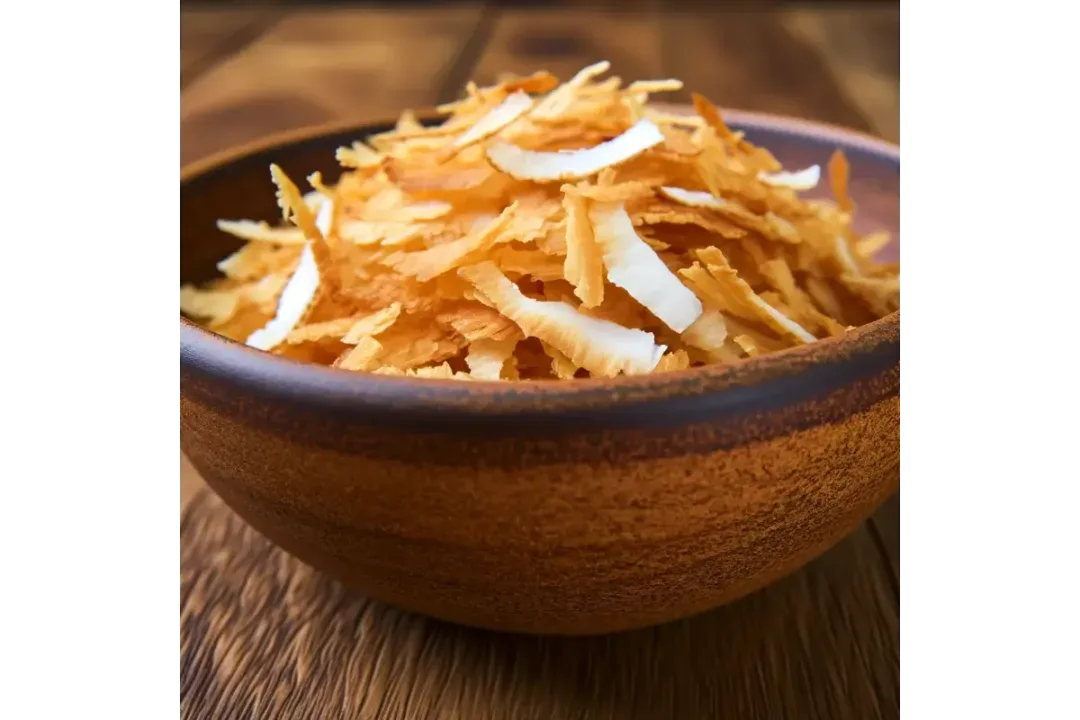Tips for Perfect Toasted Coconut
Mastering the Perfect Toast
Toasting coconut can be tricky, but with a few tips, you can avoid common pitfalls and achieve consistently golden, crispy flakes:
- Monitor Color and Texture: Watch the coconut carefully to prevent burning, as it can brown rapidly, particularly on the stovetop. Stir or shake the flakes frequently.
- Adjust Time Accordingly: Different batches can vary in moisture content and size, affecting how long it takes to toast evenly.
- Use Unsweetened Coconut for Less Browning: Sweetened coconut toasts faster and can caramelize quickly. If using sweetened coconut, check on it even more frequently.
By understanding these nuances, you’ll become a master at achieving the perfect balance between crispiness and flavor every time.
Creative Uses for Toasted Coconut

Culinary Applications of Toasted Coconut
Now that you’ve perfected your toasting coconut technique, it’s time to apply your efforts to elevate your dishes. Here are some delightful ways to use toasted coconut:
- In Desserts and Baking: Sprinkle it over cakes, cupcakes, or fruit tarts for a crunchy, aromatic topping. Incorporate it into cookies, granola bars, and muffins for added flavor.
- As a Topping for Dishes: Top yogurt parfaits, smoothie bowls, or salads with a sprinkle of toasted coconut to add a burst of flavor. It also pairs well with tropical-inspired savory dishes, like Thai curries.
To further expand your creative coconut repertoire, check out the Coconut Research Center for additional resources on health benefits and delicious recipes.
Storage and Preservation
Storing Toasted Coconut
Storing toasted coconut properly will ensure that your flakes retain their crunch and flavor for future use.
- Short-term Storage: For immediate use, cool the coconut completely before transferring it to an airtight container. Keep at ambient temperature for seven days.
- Long-term Storage and Freezing: For longer storage, keep toasted coconut in an airtight container in the refrigerator for up to a month, or in the freezer for up to three months. Thaw at room temperature before use.
Flavoring and Seasoning Toasted Coconut
Enhancing Toasted Coconut’s Flavor
After mastering the toasting process, you can experiment with additional flavorings and seasonings to create a more unique and customized taste:
- Sweet Variations: Mix sugar, cinnamon, or vanilla extract with the coconut before or after toasting for a sweeter, dessert-like flavor.
- Savory Options: Try a pinch of salt, paprika, chili powder, or curry powder to infuse savory notes that complement various main dishes.
- Layered Flavors: Blend complementary spices or extracts like cardamom, ginger, or nutmeg to layer flavors and add a complex depth.
Application Tips
- Timing: Apply seasonings after toasting for subtle flavor or before for a stronger, caramelized taste.
- Pairing with Recipes: Consider how the flavor blends with other ingredients in your dish, whether it’s granola, baked goods, or exotic salads.
By incorporating additional flavorings, you can further customize toasted coconut, offering exciting variations that appeal to both sweet and savory preferences.
Making Toasted Coconut Clusters
Crafting Coconut Clusters
For a portable, crunchy snack, consider making toasted coconut clusters:
- Ingredients: Mix together toasted coconut flakes, honey or maple syrup, and a binding agent like almond flour or oat flour. Add seeds, nuts, or dried fruits for extra flavor and texture.
- Preparation: Combine all ingredients in a bowl until well-coated. Scoop the mixture onto a baking sheet in small clusters.
- Baking: Bake the clusters at 325°F (163°C) for 10-12 minutes, stirring occasionally to ensure even browning. Let them cool completely to crisp up before storing.
These clusters make excellent toppings for yogurt, ice cream, or smoothie bowls, and are also perfect for snacking on their own. Their portability and versatility will make them a staple in your kitchen!
Creating Flavored Coconut Granola
Crafting a Nutritious Granola Blend
Combine your toasted coconut with oats, nuts, seeds, and dried fruits to make a flavorful granola mix that’s perfect for breakfast or snacking.
- Ingredients: Mix rolled oats, nuts like almonds or walnuts, seeds such as chia or sunflower seeds, and dried fruits like cranberries or raisins. Add cinnamon, honey, or maple syrup for sweetness.
- Combine with Coconut: Add toasted coconut flakes to the mixture and stir until the dry ingredients are well-coated with the sweetener.
- Bake: Spread the mixture on a baking sheet and bake at 325°F (163°C) for 20-25 minutes, stirring occasionally. Let cool completely to crisp up.
This granola can be enjoyed with yogurt, milk, or as a standalone snack. It provides a boost of fiber, healthy fats, and natural sweetness, while the toasted coconut adds a delightful crunch and tropical flavor.
Adding Toasted Coconut to Trail Mix
Creating a Portable Energy Snack
Incorporating toasted coconut into trail mix is a fantastic way to add a tropical flavor while boosting the nutritional profile.
- Ingredients: Mix together your favorite nuts (almonds, cashews, pecans), seeds (pumpkin or sunflower), dried fruits (apricots, raisins, or cranberries), and chocolate or yogurt-covered treats.
- Add Toasted Coconut: Sprinkle in a generous portion of toasted coconut flakes to enhance flavor and texture.
- Customize and Store: Adjust the ratio of ingredients based on personal taste. Store in an airtight container to keep the mix fresh and ready for hiking, traveling, or snacking at work.
This blend not only provides a burst of energy with protein, fiber, and healthy fats, but it also caters to sweet and salty cravings, all in one convenient snack mix.
FAQs
Can I Toast Coconut Without Oil?
Yes, toasting coconut can be done without oil. Whether you’re using an oven, stovetop, or microwave, there’s no need to add oil to the flakes. Just make sure you stir frequently, as natural oils will release during toasting, creating the perfect crisp.
How Long Does Toasted Coconut Last?
Toasted coconut can last up to a week at room temperature if stored in an airtight container. For longer storage, keep it in the fridge for up to a month or in the freezer for up to three months. Always let it cool completely before storing to prevent condensation.
Is Toasted Coconut Gluten-Free?
Yes, toasted coconut is gluten-free, making it a great topping or ingredient for those following a gluten-free diet. Ensure it’s not processed with other allergens to maintain its gluten-free status. For more information on a gluten-free diet, visit the Celiac Disease Foundation.
Can I Use Sweetened Coconut for Toasting?
Certainly, you can toast sweetened coconut! However, it tends to caramelize and brown more quickly than unsweetened flakes, so keep a close eye on it during toasting.
What’s the Best Coconut to Use for Toasting?
Shredded or flaked coconut works best for toasting due to its larger surface area. Desiccated coconut can also be toasted, but requires extra care to prevent burning due to its fine texture.
What Dishes Benefit Most from Toasted Coconut?
Toasted coconut pairs exceptionally well with tropical flavors like pineapple, mango, or lime. It’s also great in desserts like cakes and cookies or as a topping for breakfast bowls and salads.
Conclusion
In conclusion, learning how to toast coconut is a valuable skill that can bring unique flavor and texture to your cooking. Whether you opt for the oven, stovetop, or microwave method, mastering the art of toasting coconut will open the door to endless culinary creativity. By following proper storage guidelines, you can also keep a stash of perfectly golden flakes on hand, ready to add a delightful crunch to both sweet and savory dishes. Now, go ahead and get toasting!



